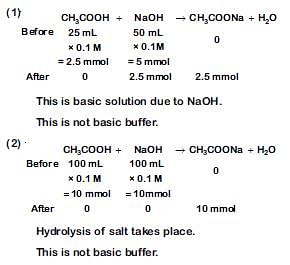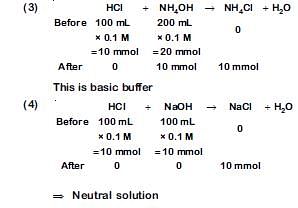JEE Exam > JEE Tests > Daily Test for JEE Preparation > Test: Buffer Solutions (27 July) - JEE MCQ
Test: Buffer Solutions (27 July) - JEE MCQ
Test Description
10 Questions MCQ Test Daily Test for JEE Preparation - Test: Buffer Solutions (27 July)
Test: Buffer Solutions (27 July) for JEE 2024 is part of Daily Test for JEE Preparation preparation. The Test: Buffer Solutions (27 July) questions and answers have been
prepared according to the JEE exam syllabus.The Test: Buffer Solutions (27 July) MCQs are made for JEE 2024 Exam. Find important
definitions, questions, notes, meanings, examples, exercises, MCQs and online tests for Test: Buffer Solutions (27 July) below.
Solutions of Test: Buffer Solutions (27 July) questions in English are available as part of our Daily Test for JEE Preparation for JEE & Test: Buffer Solutions (27 July) solutions in
Hindi for Daily Test for JEE Preparation course. Download more important topics, notes, lectures and mock
test series for JEE Exam by signing up for free. Attempt Test: Buffer Solutions (27 July) | 10 questions in 20 minutes | Mock test for JEE preparation | Free important questions MCQ to study Daily Test for JEE Preparation for JEE Exam | Download free PDF with solutions
Detailed Solution for Test: Buffer Solutions (27 July) - Question 1
Test: Buffer Solutions (27 July) - Question 2
Buffer capacity of a buffer is given as two units for a change in pH by Unity. Then what is the number of moles of acid or base, added in one litre of the solution?
Detailed Solution for Test: Buffer Solutions (27 July) - Question 2
| 1 Crore+ students have signed up on EduRev. Have you? Download the App |
Detailed Solution for Test: Buffer Solutions (27 July) - Question 3
Test: Buffer Solutions (27 July) - Question 4
What is the buffer capacity if 3 moles are added in 5 litres of the solution to change the pH by 2 units?
Detailed Solution for Test: Buffer Solutions (27 July) - Question 4
Test: Buffer Solutions (27 July) - Question 5
Which of the following is an equation used to calculate the pH of a buffer solution for an acidic buffer?
Detailed Solution for Test: Buffer Solutions (27 July) - Question 5
Test: Buffer Solutions (27 July) - Question 6
If 0.20 mol/L CH3COOH and 0.50 mol/L CH3COO– together make a buffer solution, calculate the pH of the solution if the acid dissociation constant of CH3COOH is 1.8 × 10-5.
Detailed Solution for Test: Buffer Solutions (27 July) - Question 6
Test: Buffer Solutions (27 July) - Question 7
Note that the pKa here is given by 4.752, a buffer is made using 0.8 M acetic acid and 1 M Sodium Acetate what do you think its pH is (log10/8 = 0.097)?
Detailed Solution for Test: Buffer Solutions (27 July) - Question 7
Test: Buffer Solutions (27 July) - Question 8
If the pH of a substance is given by 3 then what is the pOH of the substance?
Detailed Solution for Test: Buffer Solutions (27 July) - Question 8
Test: Buffer Solutions (27 July) - Question 9
Which of the following do you think is a correct statement?
Detailed Solution for Test: Buffer Solutions (27 July) - Question 9
Detailed Solution for Test: Buffer Solutions (27 July) - Question 10
|
360 tests
|
Information about Test: Buffer Solutions (27 July) Page
In this test you can find the Exam questions for Test: Buffer Solutions (27 July) solved & explained in the simplest way possible.
Besides giving Questions and answers for Test: Buffer Solutions (27 July), EduRev gives you an ample number of Online tests for practice



















